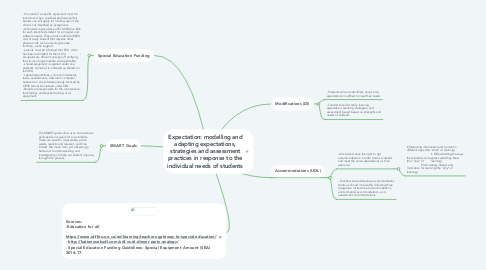Expectation: modelling and adapting expectations, strategies and assessment practices in response to the individual needs of students
by Iqra Chaudhry

1. SMART Goals
1.1. The SMART goals allow us to narrow down and specify our goals for our students. These are specific, measurable, action words, realistic and relevant, and time limited. We move from just observing a behaviour to understanding and investigating it to help out student improve through this process.
2. Modifications (DI)
2.1. - Students who are identified, have some expectations modified to meet their needs
2.2. - Teacher should modify: learning expectation, teaching strategies, and assessment based based on strengths and needs of students
3. Accommodations (UDL)
3.1. -All students have the right to get accommodations in order to be successful and meet the same expectations as their peers by:
3.1.1. • Presenting information and content in different ways (the "what" of learning) • Differentiating the ways that students can express what they know (the "how" of learning) • Stimulating interest and motivation for learning (the "why" of learning)
3.2. - Teachers should develop accommodations charts and must include the following three categories: instructional accommodations, environmental accommodations, and assessment accommodations
4. Sources: -Education for all - https://www.otffeo.on.ca/en/learning/teachers-gateway-to-special-education/ - http://katienovakudl.com/udl-vs-di-dinner-party-analogy/ - Special Education Funding Guidelines: Special Equipment Amount (SEA) 2016-17.
5. Special Education Funding
5.1. - the need of a specific equipment must be recommend by a qualified professional but boards can still apply for funding even if the child is not identified as exceptional - All boards receive base of $10,000 plus $36 for each identified student for computer and software needs. They are also liable for $800 cost of every student that requires other physical aids such as hearing devices, furniture, vision support - parents must be informed that SEA claim has been submitted for their child - A supervisory officer must sign off verifying the claims are appropriate and applicable - shared equipment is applied under one student’s name but is indicated as shared on the SEA - capital expenditures, curriculum materials, taxes, assessments, classroom computer hardware or any software already licensed by OESS cannot be claimed under SEA - Boards are responsible for the maintenance, transferring, and teacher training of all equipment



